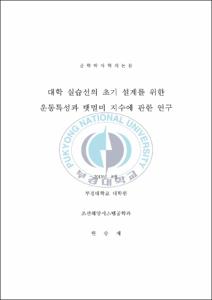대학 실습선의 초기 설계를 위한 운동특성과 뱃멀미 지수에 관한 연구
- Abstract
- Motion sickness is hardly fatal, but with symptoms such as nausea, stomach cramps and vomiting, it can certainly put a damper on your cruise fun, Motion sickness is thought to be caused by the visual disorientation resulting from being on an object in ship motion competing against our body's natural inclination for balance. Whatever the technical cause, the majority of cruisers are familiar with how rough, rocking seas can leave us feeling less than our best.
Motion sickness caused by the complex movement of ship motion combined in six degrees of freedom is bigger than that of other vehicles.
Excessive motion of ship would affect body's fatigue, cognitive ability, motion sickness, and the proficiency of activity.
Among them symptoms of motion sickness is similar to fatigue and nausea. Motion sickness causes sudden degradations of ability to perform tasks in physical and psychological aspects, and causes delays or failure in mental activity, and also takes a significant amount of time recovering.
People aboard can feel the emotions of individuals from various factors. Especially ship's motions induced by structural oscillations or external loads are directly transmitted to human body, and these make stability degradation, worsening health, activity interference, anaphylactic reaction and motion sickness, etc.
Motion sickness occurs associated with the parameters of vibrational axis, frequency, amplitude and the exposure time, etc.
Researches on ship motion and seasickness are recognized as the important research areas to ensure pleasant operative environment in addition to the research of operation safety aspects.
Generally, seakeeping performance has been evaluated as parameters of sea water intrusion, slamming, propeller racing, rolling, and acceleration caused by ship motion.
Recently, in the case of passenger ship a variety of criteria uses to assess comfort and pleasant boarding sensitivity of passengers such as motion sickness rate or MSI(Motion Sickness Incidence).
Training ship is for education and practice of students, therefore safety and pleasant embarkation should be ensured in the operation.
Ship should be built in consideration of seakeeping performance, boarding sensitivity, and safety in order to reduce degradation of body's fatigue or cognitive ability as much as possible.
In recent years, the Maritime Labour Convention organized by the International Labor Organization(ILO) is showing interest in improving living facilities, and relevant regulations are scheduled to come into force by the organization.
In design and building of new generational training ship, there is a need to be preceded by an in-depth study for ensuring the pleasant boarding sensitivity.
In this study, Maxsurf Seakeeper program based on Strip theory was used to compare and review with the experimental results of Panamax Containership. Through these works the usability of the program was verified, then numerical results of GA-YA training-ship were obtained.
Motion Sickness Incidence(MSI) of operation environment index due to exposure time of 2 hours for seasickness was expressed as the occurrent probability percentage.
Calculations of MSI for the training ship were performed with sea condition and incident angle in the main sail way, economical speed, calculation position of motion sickness, weather condition, work place, residence zone, speed variation, and incident angle.
Questionnaire of motion sickness survey was taken for the students aboard to the open sea far from land.
Motion sickness analysis was performed as comparing the results of questionnaire with the results of conditions of sea, incident angle, economical speed, and calculation position.
Through the evaluation of MSI due to changes with LCB and residence position, hull form and residence zone capable of reducing vertical acceleration were deduced.
- Issued Date
- 2013
- Awarded Date
- 2013. 8
- Type
- Dissertation
- Publisher
- 부경대학교
- Affiliation
- 대학원
- Department
- 대학원 조선해양시스템공학과
- Advisor
- 김인철
- Table Of Contents
- 제1장 서 론 1
1.1 연구의 배경 1
1.2 기존의 연구 2
1.3 논문의 개요 5
제2장 선체 운동의 이론 7
2.1 좌표계 8
2.2 운동방정식 11
2.2.1 종운동방정식 14
2.2.2 횡운동방정식 19
2.2.3 선체운동 응답함수 27
2.3 결과 및 고찰 31
2.3.1 해석 프로그램 검토 31
2.3.2 연구대상 선박제원 및 해석조건 38
2.3.3 대상선박의 종방향 RAO 해석 37
2.3.4 불규칙파중 선체운동응답스펙트럼 49
2.3.5 실습선의 운동응답스펙트럼 63
2.3.6 다방향파중 운동응답 특성 68
제3장 선박의 운항환경 지수 74
3.1 뱃멀미(Motion Sickness) 74
3.2 뱃멀미 지수(MSI) 76
3.2.1 선체 진동에 관한 국제 표준 79
3.2.2 뱃멀미와 피로에 대한 ISO 2631-3 표준 80
3.2.3 Maxsurf Seakeeper 프로그램에 대한 MSI 계산 84
3.3 MSI 계산결과 및 고찰 85
3.3.1 계산조건 85
3.3.2 계산결과 및 고찰 88
3.4 결론 102
제4장 선체운동에 따른 멀미도 조사 103
4.1 조사 대상 103
4.2 조사의 일반적 특성과 조사 방법 104
4.2.1 조사해역 및 선박의 제원 104
4.2.2 선박운항 및 해상조건 106
4.2.3 조사 방법 107
4.3 조사 결과 109
4.3.1 1차 조사 109
4.3.2 2차 조사 113
4.3.3 3차 조사 118
4.4 결과 및 고찰 122
4.5 MSI 계산과 멀미도 조사와의 비교 126
4.5.1 멀미도 조사 조건에 따른 MSI 계산의 제한점 126
4.5.2 입력데이터 126
4.5.3 설문조사와 MSI 계산의 비교 결과 128
4.6 결론 134
제5장 선형 및 거주위치 변경에 따른 MSI 개선 136
5.1 선형의 보정 136
5.2 저항성능 및 복원성능 검토 139
5.3 선형변화에 따른 MSI 성능 검토 142
5.4 거주위치 변경을 통한 수직가속도의 저감 방안 148
5.5 결론 156
제6장 결 론 158
참 고 문 헌 160
부록 : 설문지 165
- Degree
- Doctor
- Appears in Collections:
- 대학원 > 조선해양시스템공학과
- Files in This Item:
-
-
Download
 대학 실습선의 초기 설계를 위한 운동특성과 뱃멀미 지수에 관한 연구.pdf
기타 데이터 / 5.95 MB / Adobe PDF
대학 실습선의 초기 설계를 위한 운동특성과 뱃멀미 지수에 관한 연구.pdf
기타 데이터 / 5.95 MB / Adobe PDF
-
Items in Repository are protected by copyright, with all rights reserved, unless otherwise indicated.